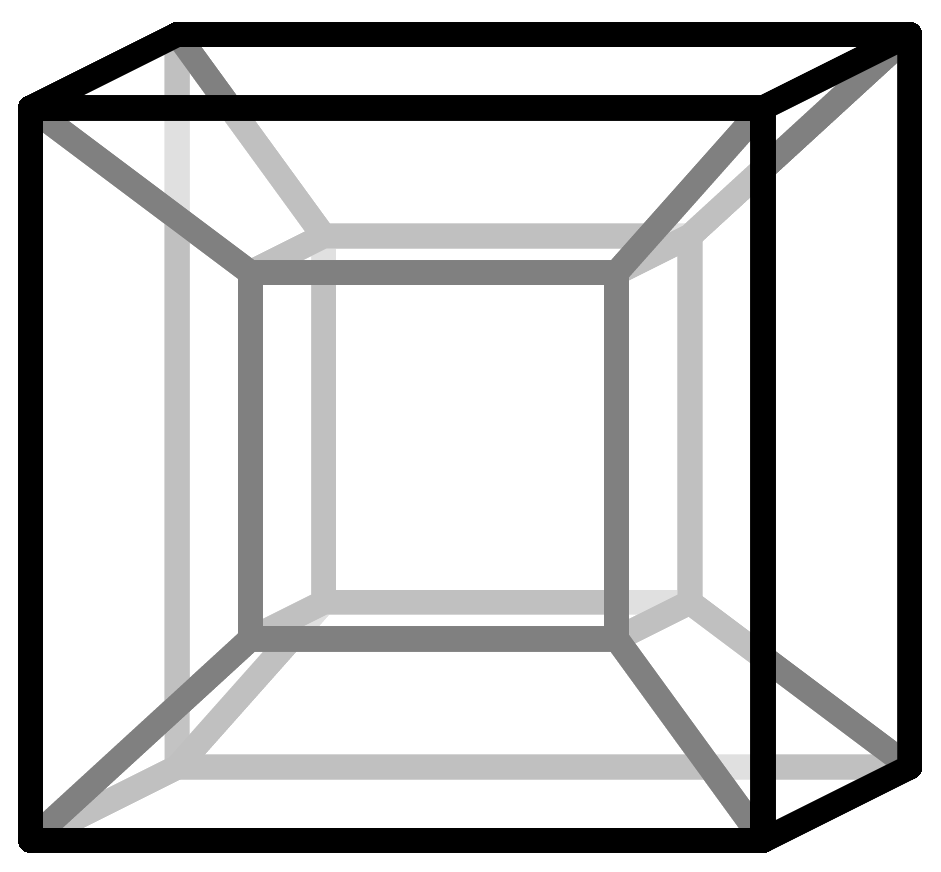Glossary
Polyhedron
Polyhedra are geometrical bodies that consist of vertices, straight edges and flat faces. In our project we restrict ourselves to convex polyhedra. This means that all inner angles between two edges or two faces are less or equal to 180°. No cavities, holes or indentations are allowed.
The most prominent examples of polyhedra are the cube and the pyramid. You also may have encountered the prism or the octahedron. But there are so many more polyhedra.
The Platonic solids are a very symmetric and regular class of five polyhedra. They consist only of congruent (same shape and size), regular (all sides the same length) polygons. The tetrahedron, the octahedron and the icosahedron comprise of regular triangles. In every corner of the tetrahedron, three triangles meet. In the case of the octahedron four and with the icosahedron five triangles build a joint at each vertex. If you put six equilateral triangles at a vertex, which each have an interior angle of 60°, you get a full circle of 360° and they lie flat on the ground. Therefore, no new body emerges. Similarly, the cube is built from three squares and the dodecahedron from three equilateral pentagons at each vertex. Euclid used this approach in his proof to show that there can be no further polyhedra with these properties, thus classifying the five Platonic solids.
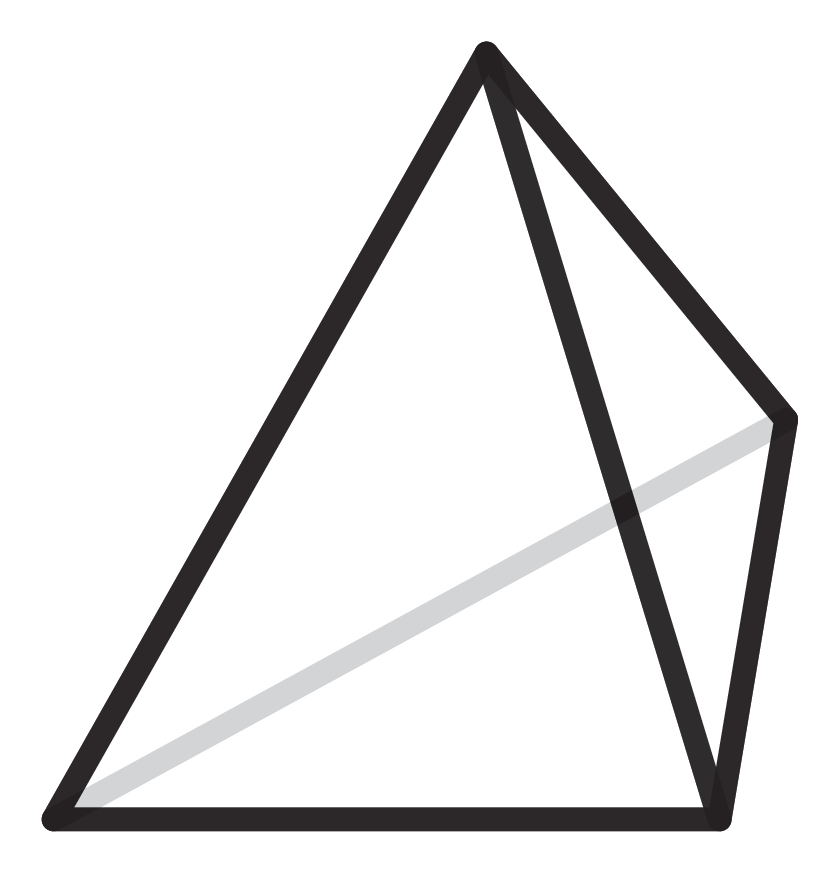
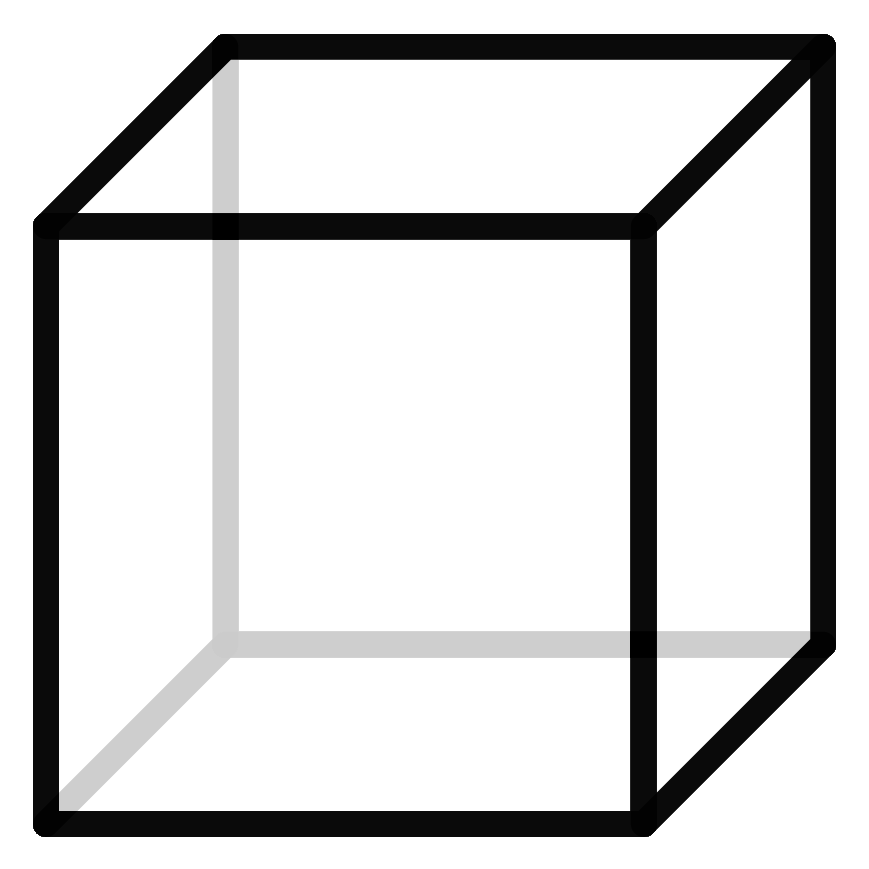
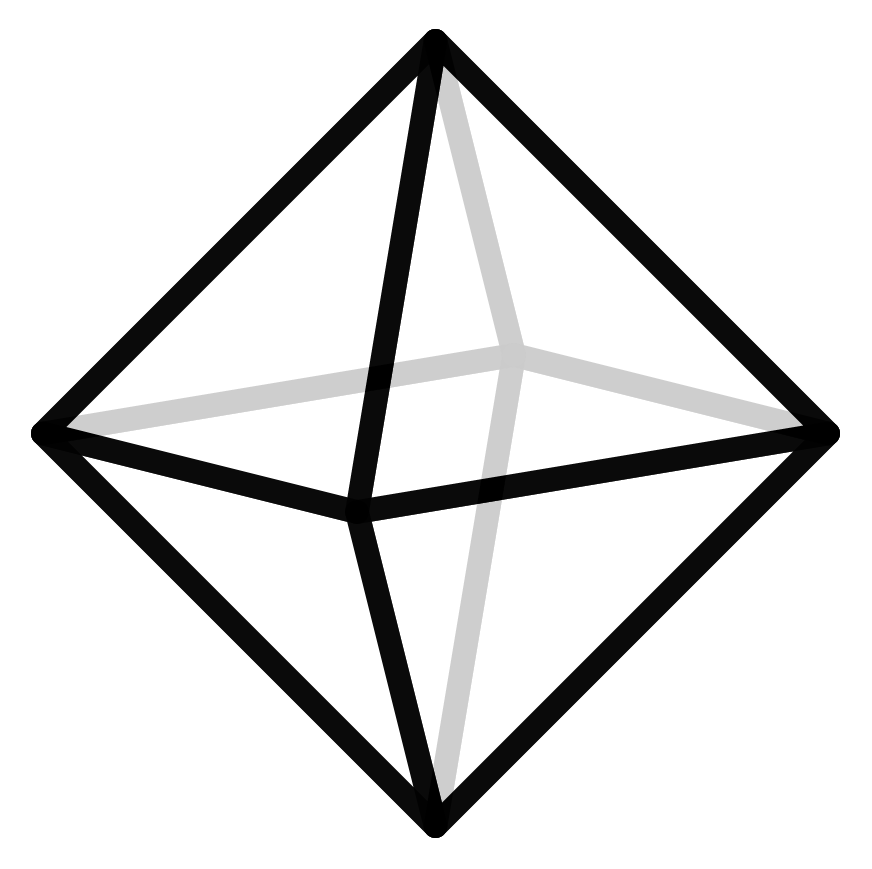

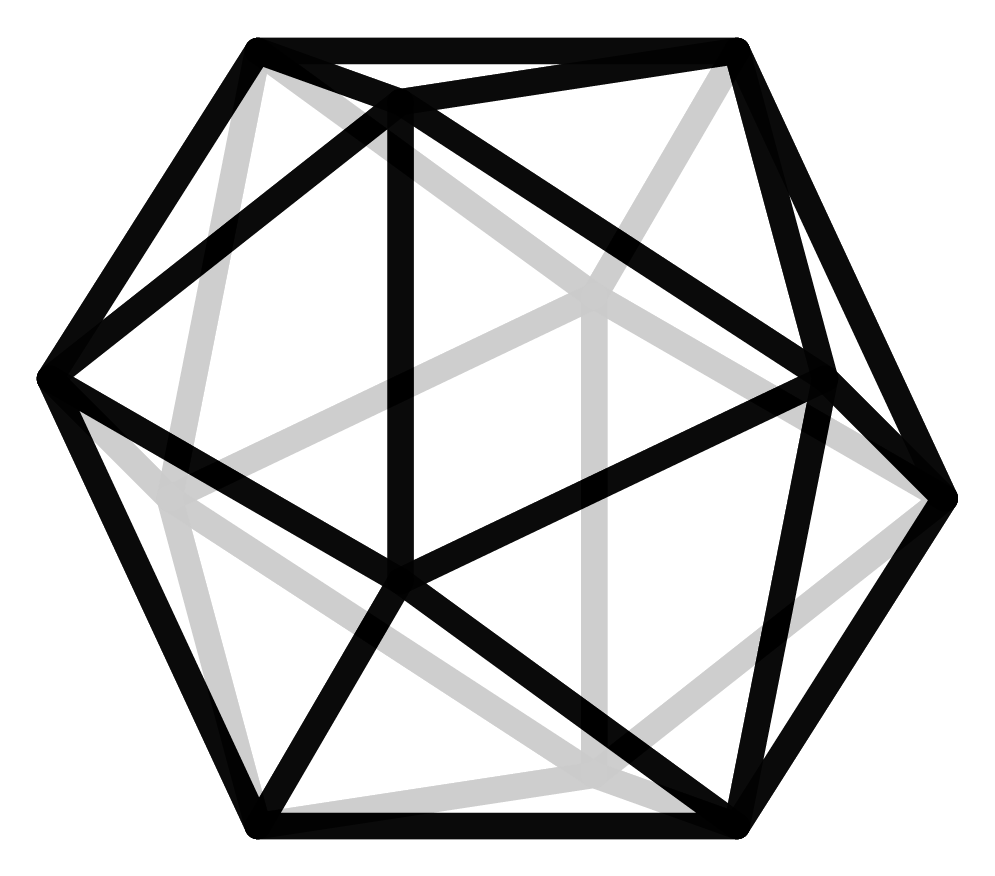
But symmetric polyhedra are not the only interest of mathematicians. For their research they are searching for polyhedra (or their higher-dimensional equivalent, the polytopes) that have specific properties. We have asked some geometers – this is what the mathematicians who study geometry are called – about their favorite polyhedra and this is what they said:
“If polytopes could be viewed as rocks, then the associahedron is the diamond of polytopes. Diamonds are made of a very common element in nature–carbon–and likewise the associahedron can be realized via very common tools. Yet it enjoys such a unique and rare structure–and provides such a fascination–that no other polytope may ever be compared to the diamond.” - Jean-Philippe Labbé.

“My favorite 3-polytope is the icosahedron, for its complexity yet simplicity. If you start gluing equilateral triangles, five at a vertex, and no matter what you do you end up with this nice thing. When I got bored in high school (which, yes, happened), I drew icosahedra in the margins in my notebooks. Sometimes they were not totally regular; I amused myself making them look like faces. Last but not least, I am fascinated by the fact that you can decompose its 12 vertices into three golden rectangles intertwined as Borromean rings.” - Francisco Santos.

“My favourite polyhedron is “Miller’s solid”, also known as the ”pseudo-rhombicuboctahedron“ or as the ”elongated square gyrobicupola“, probably first found by D. M. Y. Sommerville in 1905 — an object that was often overlooked (already by Archimedes?), discovered and rediscovered (by J. C. P. Miller, among others). It is pretty, but if you look closely it has a certain twist, so it is not perfect. It looks classical, like an Archimedean solid, but it isn’t really, at least according to the modern definition of an Archimedean solid. Thus it is a good reminder that we have to be careful with definitions in mathematics, and always look at possible exceptions and special cases.” - Günter M. Ziegler.
„My favourite polyhedra are the Koebe polyhedra. All their edges touch a sphere. All faces of these polyhedra have inscribed discs. The discs of neighbouring faces touch. These exist an explicit dualization procedure that generates discrete minimal surfaces from Koebe polyhedra. The corresponding surface is then a discrete P-Schwarz surface and the Koebe polyhedron is its Gauss map. One can read more in: A.I. Bobenko, T. Hoffmann, B.A. Springborn, Minimal surfaces from circle patterns: Geometry from combinatorics, Ann. of Math. 164:1 (2006) 231-264) and can watch the movie: (http://discretization.de/en/movies/koebe/).“ - Alexander Bobenko.
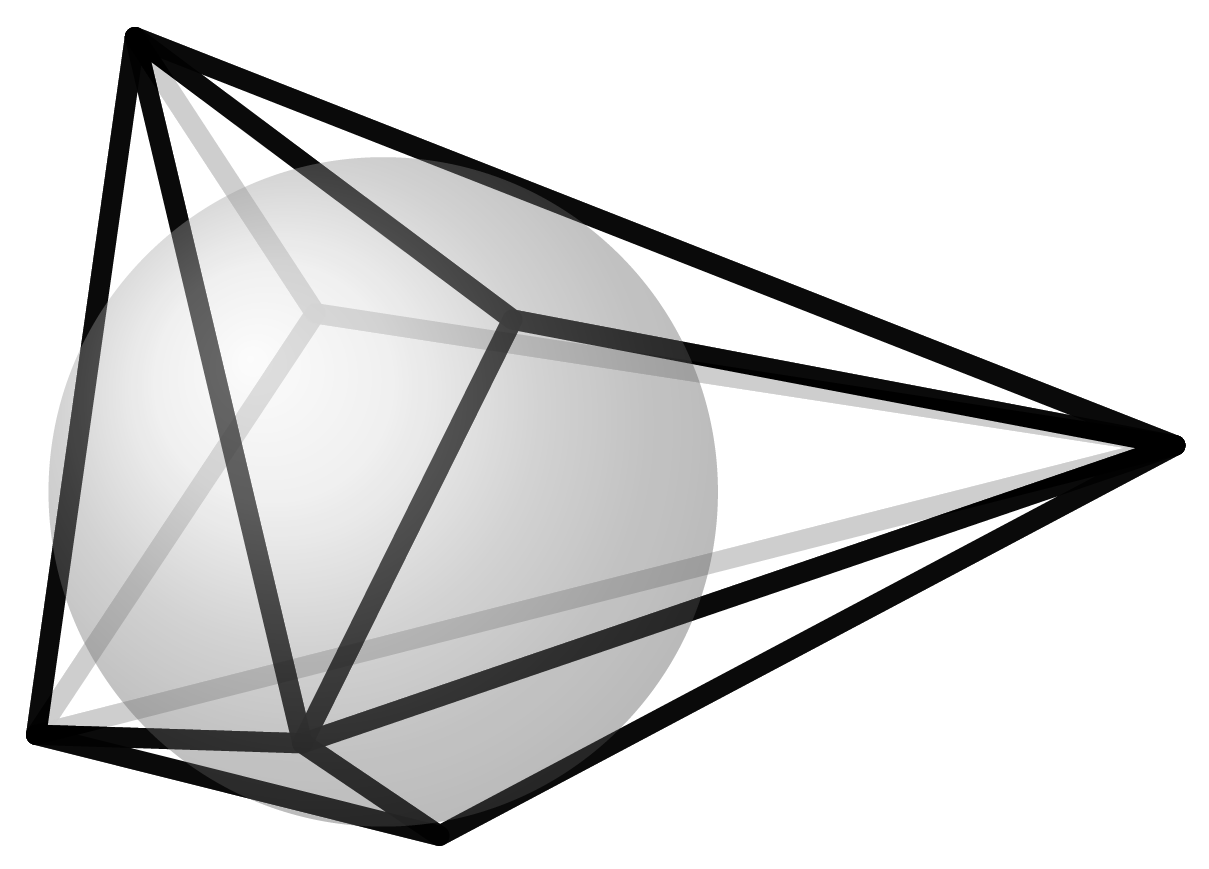
Polygon
A polygon is a two-dimensional polyhedron which consists of vertices and edges. The area bounded by the edges is the polygon itself. Three-dimensional polyhedra are made up of vertices, edges and polygons, i.e., the faces.
A special class of polygons are called the regular polygons. They are made up of equilateral edges (all the same length) and all their inner angles are the same. Some examples of regular polygons are the square, equilateral triangle, and equilateral pentagon. Regular polygons form the building blocks for the Platonic and Archimedean solids.
Polyhedral Nets
If you cut a hollow cube on enough edges, unfold it and lay it flat on the plane, you get what is called the net of the cube. If you draw this net on paper, you get an outline which you can cut out and glue together to form the cube. Of course, this method works for any polyhedra. In our project, we use exactly these templates to build our models. We simulated this process of cutting open and unfolding polyhedra with a computer and automatically created the nets of the polyhedra.


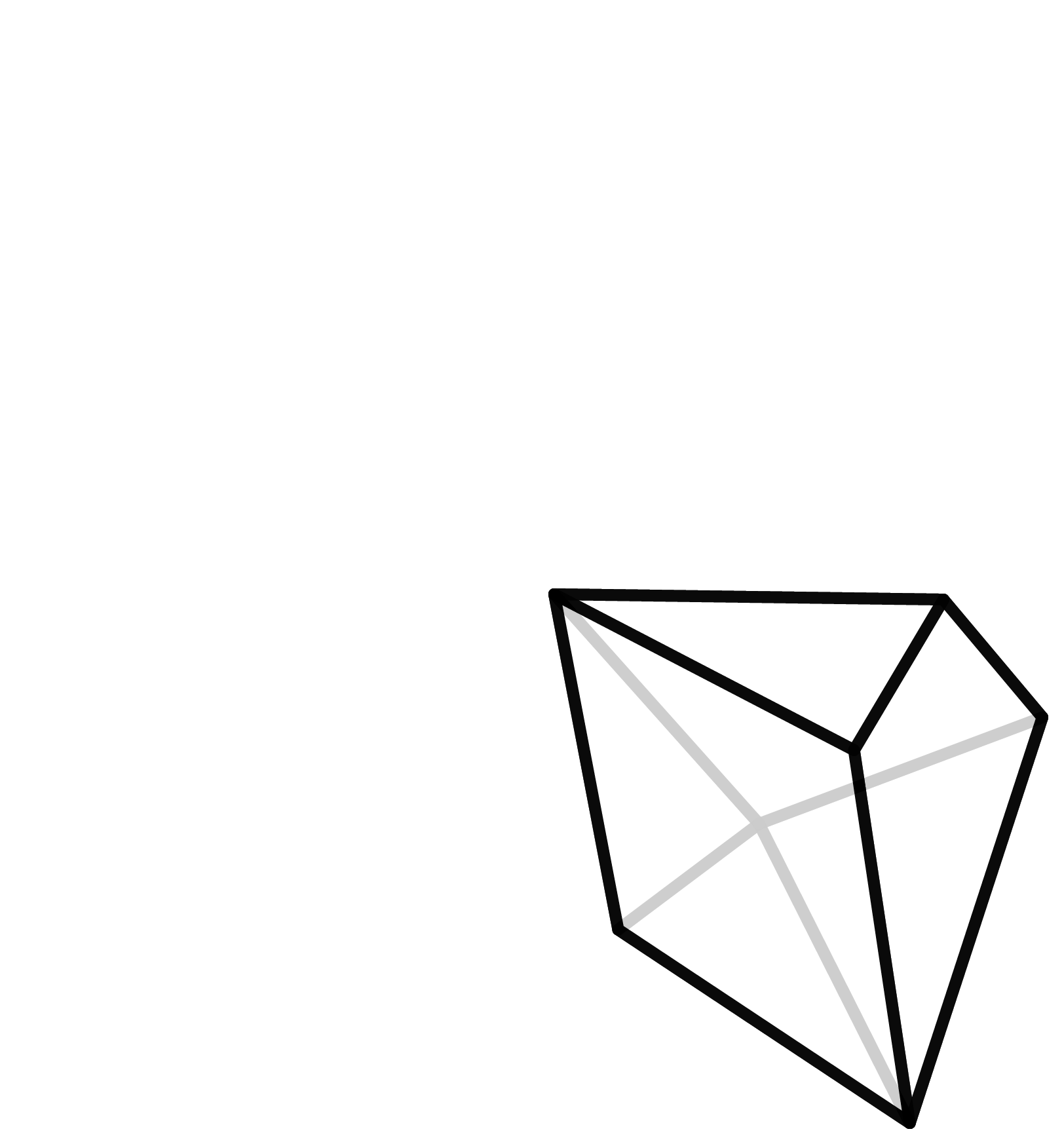

A cube with its net and a polygon with seven corners and the associated net.
Archimedian Solids
Another very symmetric and hence “beautiful” class of polyhedra are the Archimedean Solids. They also only consist of regular polygons, but here unlike the Platonic Solids a combination of them is allowed. The most common representative is the soccer ball. Mathematicians would rather speak of a truncated icosahedron, since it emerges when you chop off the tip of each vertex of an icosahedron.


On the left an icosahedron and on the right its truncation - a soccer ball.
How many polyhedra are there?
For every fixed number of vertices, there are a certain number of polyhedra. In the table, the number of different types of polyhedra is given for the number of vertices. It is clear that the number of types increases rapidly. If you have four points in space, they are either all on the same level (not three-dimensional), or the shape will be a pyramid over a triangle. Therefore, there is only one polyhedron with four vertices, the tetrahedron.
| Ecken | Polyeder |
| 4 | 1 |
| 5 | 2 |
| 6 | 7 |
| 7 | 34 |
| 8 | 257 |
| 9 | 2.606 |
| 10 | 32.300 |
| 11 | 440.564 |
| 12 | 6.384.634 |
| 13 | 96.262.938 |
| 14 | 1.496.225.352 |
| 15 | 23.833.988.129 |
| 16 | 387.591.510.244 |
| 17 | 6.415.851.530.241 |
| 18 | 107.854.282.197.058 |
| 19 | ??? |
For five vertices, there are two possibilities: the pyramid over the square, if four of the five vertices lie the same plane, or the double pyramid over a triangle. For six vertices, finding the seven different types starts to get more complicated.

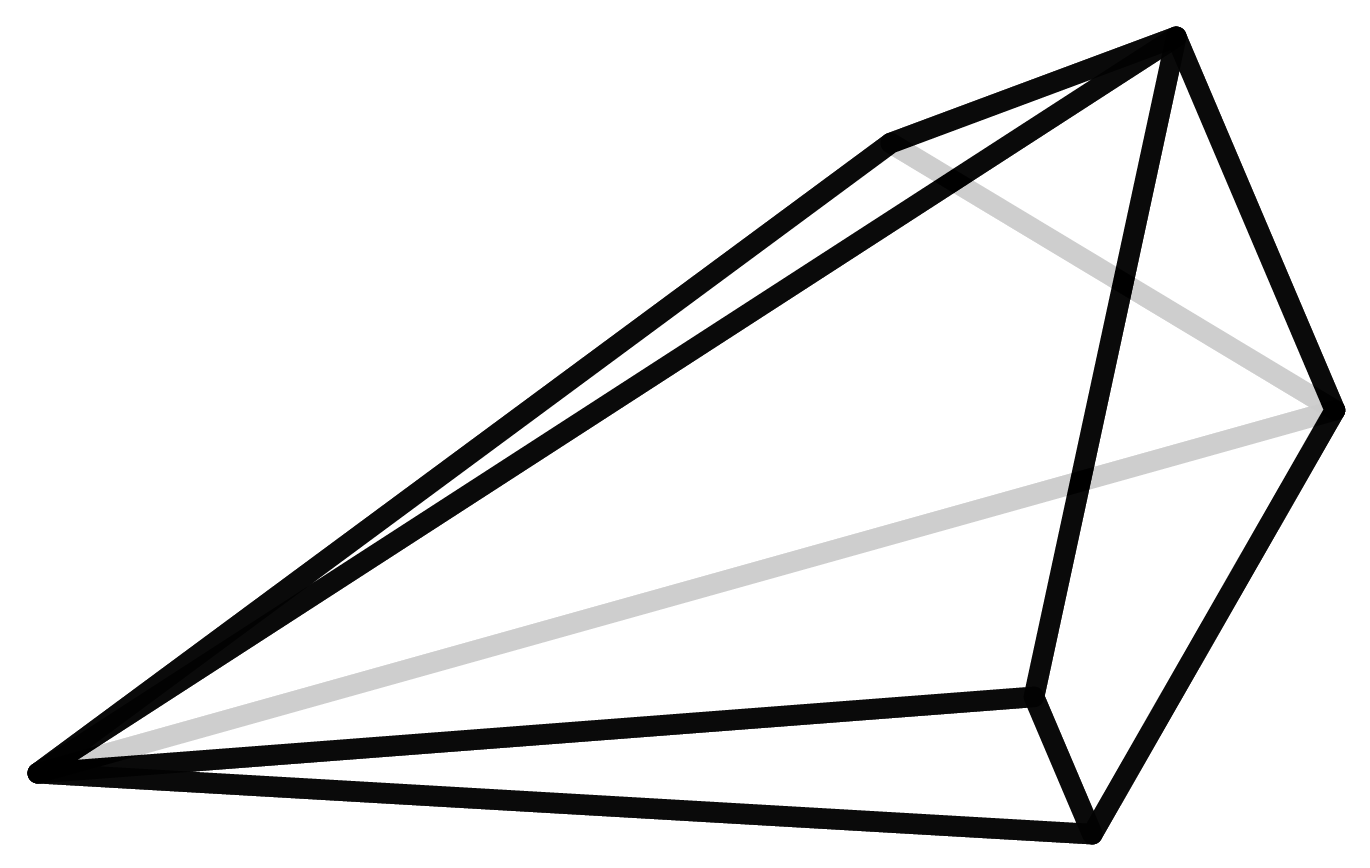





In order to find out how many polyhedra types actually exist for each number of vertices, we have to create and list them. But how do you know that this list is complete and no polyhedron is counted twice? In geometry, Steinitz’s Theorem states that each polyhedron can be uniquely assigned to a graph with certain properties. (Here the notion of a graph is not referring to the ones living in coordinate systems but the ones that are subject to graph theory). These graphs are mathematically easier to grasp and therefore count. But even for this, you will need a computer because the numbers get very large very fast. The number of seven- and eight-vertice polyhedra, 34 and 257 respectively, were found back in 1899. For the discovery of the 2606 nine-vertice polyhedra in the year 1969 the invention of the computer was necessary.
Dimension
In mathematics, there are many ways to interpret dimensions. One way is to imagine dimensions as the number of variables. For example, the ingredients of an apple pie (flour, butter, sugar, eggs, baking soda and apples) can be understood as six variables and therefore the apple pie is a six-dimensional object.
By looking at photos and films, which are a representation of our three-dimensional world in a two-dimensional medium, we are used to seeing an extra dimension. This process of mapping a higher dimension into a lower one, that is taking a two-dimensional photograph of the three-dimensional world, is called a projection in mathematics.
Unfortunately, it is not possible to truly represent four-dimensional space in the three-dimensional space surrounding us, but we can use projections to understand it. For example, if you look at a cube, its faces are squares. A square can be thought of as a two-dimensional cube, because all its sides are the same length, so the sides of the three-dimensional cube are two-dimensional cubes. This idea extends to higher dimensions. The side surfaces of a four-dimensional cube are three-dimensional cubes. The result is a so-called tesseract. Here is a link to a video where this relationship is graphically visualized.
Convex/Convexity
When we speak of polyhedra, we silently assume that they are convex polyhedra. Convex means that there are no indentations, cavities or holes. The mathematical definition of convexity states that for any two points that lie within a set, a straight line connecting them must lie completely within the set.

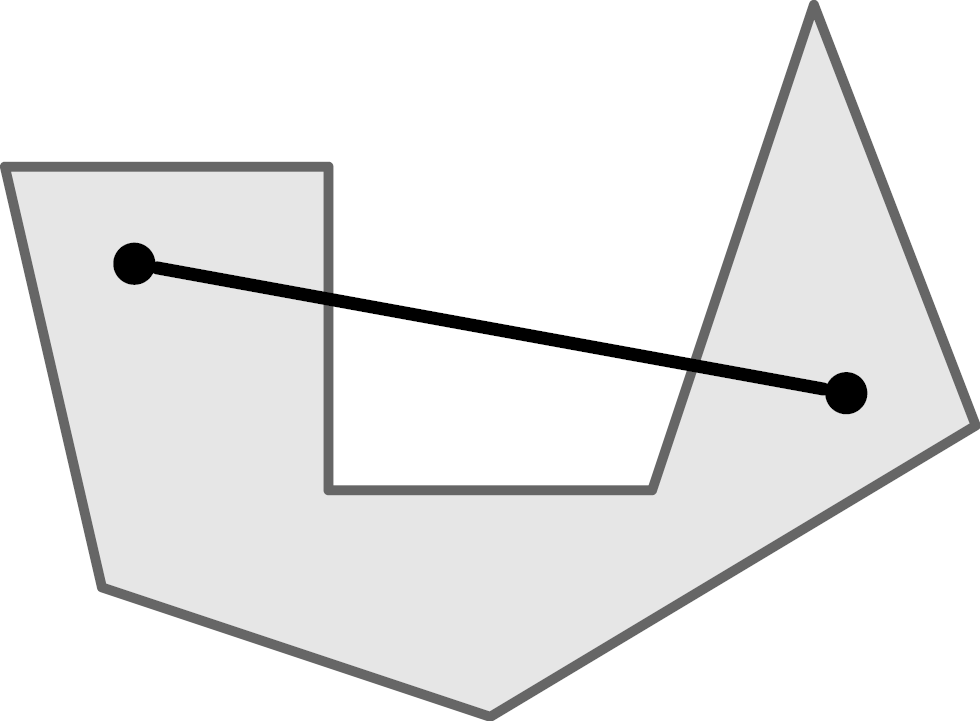
On the left a convex, on the right a non-convex object.
Combinatorial Type
Each polyhedron can be geometrically realized in different ways. It can be big or small, and its shape can also be changed, as long as the structure of the vertices, edges and surfaces remains the same. This structure, which is the number of edges meeting at the vertices, and the number of vertices belonging to each surface, is called the combinatorial type of a polyhedron. We call two polyhedra combinatorially equivalent if they possess the same combinatorial type, i.e., one can uniquely assign vertices to each other so that if two vertices in one polyhedron are connected by an edge, then the vertices in the other polyhedron are connected by an edge. Every polyhedron has an infinite number of different geometric interpretations. If you choose a polyhedron on Polytopia.eu, you will adopt the entire combinatorial type. So you have actually adopted infinitely many polyhedra. To make it less confusing and easier to make the model, we have chosen a clear realization of the polyhedron. These are the so-called Koebe-Andreev-Thurston realizations of polyhedra. In particular, these realizations have a sphere inscribed inside the polyhedra that touches each of the edges at exactly one point. In particular, each surface contains a circle that touches the edges just once.

f-Vector
The f-vector of the polyhedron indicates how many vertices, edges, and faces it has. A vector in this case is not a geometric quantity but only the way of representing these numbers. The cube consists of 8 vertices, 12 edges, and 6 faces, and thus has the f-vector (8,12,6). However, the polyhedra are not uniquely determined by this vector. There may be other polyhedra with the same f-vector that have a completely different structure. We call these polyhedra siblings.


Here we see a cube and its sister. She also possesses 6 faces, 12 edges, and 8 vertices but contains an entirely different structure that the cube.
Mathematical Models
Physical models and their construction have long played an important role in mathematics. For one thing, there was simply no other way to understand ideas in a three-dimensional environment. Of course, three-dimensional models can always be drawn, but then the drawing is only a projection of the model onto the plane, much like taking a picture of the model. When it comes to photos of familiar objects, recognizing the space does not cause us any problems, because we know, for example, that a table is usually right-angled. If we see a perspectively distorted table in a photo, we intuitively know about the right angles. Of course, this intuition is not there when trying to understand the structure of an unfamiliar geometric object. In order to recognize certain properties, such as an axis of symmetry, it is very helpful to actually hold an object in your hand and turn it.
Models serve not only to gain knowledge but also to share knowledge. To make their research accessible to others, mathematicians needed a way to visualize it. Nowadays, this is done mainly with computers. There is a lot of software to generate mathematical and geometric graphics. Rotation of a model using this software also counteracts the problem of restriction to the flat screen.
Dürer’s Conjecture
Although mathematicians have been dealing with polyhedra since ancient times, not everything is known about them. For one thing, every question that is answered only brings about new questions. For example, the number of three-dimensional polyhedra is known only up to 18 vertices. If somebody should find out how many polyhedra there are with 19 vertices, one can immediately ask about the number of polyhedra with 20 vertices. There are also questions that have been waiting a long time for an answer. A „nice“ example, because it is easy to understand and yet still an unsolved problem, is the so-called Dürer conjecture. The painter Albrecht Dürer spent some years studying mathematics and the concept of the net of a polyhedron goes back to him. In his book, „The Painter’s Manual“ he drew nets of several polyhedra.

A net of a polyhedron is created by considering the polyhedron as an empty shell, which is cut along its edges in such a way that it remains connected but can be laid flat without distorting the faces. The question behind Dürer’s conjecture is whether this is possible for every polyhedron such that the faces do not overlap when it is unfolded. In other words, does every polyhedron have a net?
To date, many mathematicians have considered this question and there are some intermediate results. For example, it is known that you can unfold any polyhedron without overlap if you pull and distort the faces and thus change its geometrical realization but not its structure (s. https://arxiv.org/pdf/1305.3231.pdf). The only polyhedron for which we know for sure that can always be unfolded without changing its geometrical structure is the tetrahedron.
Since we have automatically generated the unfoldings for the polyhedra in our project, it is possible that the net of your adopted polyhedron is overlapping. If so, write us an email!
Siblings
Polyhedra are siblings if they contain the same number of vertices, edges and faces, hence the same f-vector. Similar to human siblings, some polyhedral siblings do look alike each other while others have a completely different form. The cube consists of 8 vertices, 12 edges and 6 faces. These numbers do not uniquely define its structure. There are polyhedra who have the same f-vector but an entirely different structure.
Siblings:Sibling 1000003, Sibling 1000004, Sibling 1000007, Sibling 1000011, Sibling 1000027, Sibling 1000033, Sibling 1000034, Sibling 1000037, Sibling 1000046, Sibling 1000047, Sibling 1000051, Sibling 1000059, Sibling 1000062, Sibling 1000064, Sibling 1000066, Sibling 1000069, Sibling 1000074, Sibling 1000076, Sibling 1000080, Sibling 1000082, . . .
Sibling 1000086, Sibling 1000088, Sibling 1000094, Sibling 1000096, Sibling 1000099, Sibling 1000104, Sibling 1000105, Sibling 1000107, Sibling 1000110, Sibling 1000114, Sibling 1000117, Sibling 1000124, Sibling 1000167, Sibling 1000177, Sibling 1000207, Sibling 1000209, Sibling 1000211, Sibling 1000214, Sibling 1000221, Sibling 1000223, Sibling 1000237, Sibling 1000239, Sibling 1000242, Sibling 1000244, Sibling 1000250, Sibling 1000251, Sibling 1000254, Sibling 1000259, Sibling 1000266, Sibling 1000270, Sibling 1000271, Sibling 1000274, Sibling 1000275, Sibling 1000278, Sibling 1000279, Sibling 1000283, Sibling 1000287, Sibling 1000288, Sibling 1000290, Sibling 1000295, Sibling 1000298, Sibling 1000314, Sibling 1000318, Sibling 1000320, Sibling 1000322, Sibling 1000327, Sibling 1000329, Sibling 1000333, Sibling 1000335, Sibling 1000336, Sibling 1000338, Sibling 1000339, Sibling 1000341, Sibling 1000349, Sibling 1000351, Sibling 1000353, Sibling 1000360, Sibling 1000362, Sibling 1000364, Sibling 1000365, Sibling 1000367, Sibling 1000371, Sibling 1000375, Sibling 1000377, Sibling 1000382, Sibling 1000383, Sibling 1000386, Sibling 1000393, Sibling 1000396, Sibling 1000398, Sibling 1000399, Sibling 1000402, Sibling 1000403, Sibling 1000406, Sibling 1000410, Sibling 1000412, Sibling 1000416, Sibling 1000419, Sibling 1000420, Sibling 1000422, Sibling 1000429, Sibling 1000436, Sibling 1000438, Sibling 1000440, Sibling 1000441, Sibling 1000443, Sibling 1000445, Sibling 1000447, Sibling 1000449, Sibling 1000464, Sibling 1000469, Sibling 1000471, Sibling 1000475, Sibling 1000478, Sibling 1000493, Sibling 1000501, Sibling 1000506, Sibling 1000508, Sibling 1000509, Sibling 1000512, Sibling 1000519, Sibling 1000538, Sibling 1000539, Sibling 1000565, Sibling 1000572, Sibling 1000574, Sibling 1000580, Sibling 1000586, Sibling 1000592, Sibling 1000595, Sibling 1000596, Sibling 1000600, Sibling 1000608, Sibling 1000609, Sibling 1000617, Sibling 1000623, Sibling 1000625, Sibling 1000628, Sibling 1000632, Sibling 1000634, Sibling 1000638, Sibling 1000639, Sibling 1000642, Sibling 1000648, Sibling 1000654, Sibling 1000656, Sibling 1000659, Sibling 1000660, Sibling 1000664, Sibling 1000667, Sibling 1000670, Sibling 1000674, Sibling 1000676, Sibling 1000677, Sibling 1000680, Sibling 1000683, Sibling 1000687, Sibling 1000688, Sibling 1000690, Sibling 1000692, Sibling 1000701, Sibling 1000704, Sibling 1000707, Sibling 1000708, Sibling 1000709, Sibling 1000713, Sibling 1000727, Sibling 1000734, Sibling 1000744, Sibling 1000747, Sibling 1000750, Sibling 1000751, Sibling 1000754, Sibling 1000755, Sibling 1000759, Sibling 1000764, Sibling 1000765, Sibling 1000772, Sibling 1000774, Sibling 1000777, Sibling 1000788, Sibling 1000789, Sibling 1000791, Sibling 1000793, Sibling 1000799, Sibling 1000801, Sibling 1000803, Sibling 1000807, Sibling 1000810, Sibling 1000813, Sibling 1000817, Sibling 1000820, Sibling 1000821, Sibling 1000833, Sibling 1000867, Sibling 1000874, Sibling 1000875, Sibling 1000882, Sibling 1000887, Sibling 1000888, Sibling 1000904, Sibling 1000907, Sibling 1000912, Sibling 1000914, Sibling 1000917, Sibling 1000919, Sibling 1000926, Sibling 1000933, Sibling 1000934, Sibling 1000938, Sibling 1000941, Sibling 1000942, Sibling 1000944, Sibling 1000948, Sibling 1000958, Sibling 1000960, Sibling 1000963, Sibling 1000965, Sibling 1000967, Sibling 1000972, Sibling 1000973, Sibling 1000975, Sibling 1000977, Sibling 1000983, Sibling 1000985, Sibling 1000988, Sibling 1000990, Sibling 1000991, Sibling 1000995, Sibling 1000998, Sibling 1001001, Sibling 1001003, Sibling 1001007, Sibling 1001024, Sibling 1001027, Sibling 1001029, Sibling 1001031, Sibling 1001034, Sibling 1001039, Sibling 1001043, Sibling 1001045, Sibling 1001049, Sibling 1001054, Sibling 1001059, Sibling 1001064, Sibling 1001067, Sibling 1001075, Sibling 1001079, Sibling 1001080, Sibling 1001082, Sibling 1001086, Sibling 1001087, Sibling 1001089, Sibling 1001094, Sibling 1001097, Sibling 1001099, Sibling 1001101, Sibling 1001103, Sibling 1001106, Sibling 1001111, Sibling 1001121, Sibling 1001125, Sibling 1001130, Sibling 1001132, Sibling 1001135, Sibling 1001137, Sibling 1001138, Sibling 1001144, Sibling 1001145, Sibling 1001153, Sibling 1001180, Sibling 1001184, Sibling 1001186, Sibling 1001189, Sibling 1001193, Sibling 1001195, Sibling 1001198, Sibling 1001199, Sibling 1001200, Sibling 1001202, Sibling 1001214, Sibling 1001217, Sibling 1001226, Sibling 1001227, Sibling 1001229, Sibling 1001235, Sibling 1001238, Sibling 1001242, Sibling 1001246, Sibling 1001248, Sibling 1001250, Sibling 1001251, Sibling 1001255, Sibling 1001260, Sibling 1001261, Sibling 1001264, Sibling 1001266, Sibling 1001269, Sibling 1001272, Sibling 1001275, Sibling 1001277, Sibling 1001283, Sibling 1001285, Sibling 1001288, Sibling 1001290, Sibling 1001292, Sibling 1001293, Sibling 1001298, Sibling 1001300, Sibling 1001302, Sibling 1001306, Sibling 1001310, Sibling 1001312, Sibling 1001314, Sibling 1001315, Sibling 1001320, Sibling 1001323, Sibling 1001327, Sibling 1001328, Sibling 1001331, Sibling 1001341, Sibling 1001357, Sibling 1001359, Sibling 1001362, Sibling 1001364, Sibling 1001373, Sibling 1001384, Sibling 1001393, Sibling 1001396, Sibling 1001406, Sibling 1001410, Sibling 1001414, Sibling 1001417, Sibling 1001420, Sibling 1001422, Sibling 1001423, Sibling 1001426, Sibling 1001428, Sibling 1001430, Sibling 1001434, Sibling 1001436, Sibling 1001442, Sibling 1001444, Sibling 1001450, Sibling 1001454, Sibling 1001465, Sibling 1001467, Sibling 1001482, Sibling 1001486, Sibling 1001501, Sibling 1001507, Sibling 1001513, Sibling 1001514, Sibling 1001521, Sibling 1001523, Sibling 1001525, Sibling 1001531, Sibling 1001534, Sibling 1001541, Sibling 1001542, Sibling 1001544, Sibling 1001546, Sibling 1001551, Sibling 1001552, Sibling 1001554, Sibling 1001557, Sibling 1001558, Sibling 1001559, Sibling 1001573, Sibling 1001584, Sibling 1001587, Sibling 1001599, Sibling 1001600, Sibling 1001602, Sibling 1001604, Sibling 1001608, Sibling 1001614, Sibling 1001618, Sibling 1001619, Sibling 1001622, Sibling 1001625, Sibling 1001626, Sibling 1001629, Sibling 1001631, Sibling 1001634, Sibling 1001636, Sibling 1001638, Sibling 1001640, Sibling 1001643, Sibling 1001645, Sibling 1001647, Sibling 1001652, Sibling 1001653, Sibling 1001658, Sibling 1001665, Sibling 1001667, Sibling 1001668, Sibling 1001674, Sibling 1001676, Sibling 1001679, Sibling 1001682, Sibling 1001683, Sibling 1001686, Sibling 1001689, Sibling 1001691, Sibling 1001694, Sibling 1001695, Sibling 1001698, Sibling 1001701, Sibling 1001703, Sibling 1001705, Sibling 1001708, Sibling 1001709, Sibling 1001712, Sibling 1001715, Sibling 1001718, Sibling 1001722, Sibling 1001728, Sibling 1001737, Sibling 1001739, Sibling 1001742, Sibling 1001753, Sibling 1001798, Sibling 1001800, Sibling 1001803, Sibling 1001809, Sibling 1001815, Sibling 1001826, Sibling 1001831, Sibling 1001833, Sibling 1001842, Sibling 1001853, Sibling 1001854, Sibling 1001861, Sibling 1001866, Sibling 1001867, Sibling 1001869, Sibling 1001871, Sibling 1001878, Sibling 1001889, Sibling 1001890, Sibling 1001892, Sibling 1001903, Sibling 1001908, Sibling 1001917, Sibling 1001923, Sibling 1001930, Sibling 1001933, Sibling 1001935, Sibling 1001937, Sibling 1001941, Sibling 1001943, Sibling 1001945, Sibling 1001949, Sibling 1001950, Sibling 1001954, Sibling 1001957, Sibling 1001961, Sibling 1001965, Sibling 1001967, Sibling 1001969, Sibling 1001972, Sibling 1001974, Sibling 1001977, Sibling 1001978, Sibling 1001979, Sibling 1001987, Sibling 1001992, Sibling 1002001, Sibling 1002004, Sibling 1002007, Sibling 1002008, Sibling 1002011, Sibling 1002013, Sibling 1002016, Sibling 1002018, Sibling 1002019, Sibling 1002024, Sibling 1002028, Sibling 1002031, Sibling 1002032, Sibling 1002037, Sibling 1002040, Sibling 1002042, Sibling 1002046, Sibling 1002048, Sibling 1002053, Sibling 1002055, Sibling 1002059, Sibling 1002061, Sibling 1002063, Sibling 1002065, Sibling 1002076, Sibling 1002079, Sibling 1002084, Sibling 1002087, Sibling 1002089, Sibling 1002092, Sibling 1002095, Sibling 1002097, Sibling 1002100, Sibling 1002104, Sibling 1002106, Sibling 1002112, Sibling 1002117, Sibling 1002126, Sibling 1002146, Sibling 1002147, Sibling 1002151, Sibling 1002156, Sibling 1002157, Sibling 1002194, Sibling 1002215, Sibling 1002218, Sibling 1002223, Sibling 1002224, Sibling 1002225, Sibling 1002228, Sibling 1002232, Sibling 1002233, Sibling 1002237, Sibling 1002239, Sibling 1002250, Sibling 1002261, Sibling 1002262, Sibling 1002265, Sibling 1002267, Sibling 1002270, Sibling 1002277, Sibling 1002290, Sibling 1002310, Sibling 1002315, Sibling 1002316, Sibling 1002319, Sibling 1002322, Sibling 1002324, Sibling 1002327, Sibling 1002334, Sibling 1002337, Sibling 1002340, Sibling 1002341, Sibling 1002343, Sibling 1002354, Sibling 1002356, Sibling 1002358, Sibling 1002359, Sibling 1002361, Sibling 1002366, Sibling 1002368, Sibling 1002372, Sibling 1002374, Sibling 1002379, Sibling 1002380, Sibling 1002383, Sibling 1002387, Sibling 1002389, Sibling 1002394, Sibling 1002403, Sibling 1002408, Sibling 1002409, Sibling 1002418, Sibling 1002421, Sibling 1002429, Sibling 1002430, Sibling 1002435, Sibling 1002438, Sibling 1002439, Sibling 1002442, Sibling 1002446, Sibling 1002462, Sibling 1002465, Sibling 1002471, Sibling 1002499, Sibling 1002503, Sibling 1002506, Sibling 1002512, Sibling 1002513, Sibling 1002515, Sibling 1002525, Sibling 1002527, Sibling 1002529, Sibling 1002535, Sibling 1002536, Sibling 1002540, Sibling 1002541, Sibling 1002543, Sibling 1002544, Sibling 1002546, Sibling 1002549, Sibling 1002550, Sibling 1002553, Sibling 1002559, Sibling 1002564, Sibling 1002573, Sibling 1002605, Sibling 1002610, Sibling 1002620, Sibling 1002636, Sibling 1002639, Sibling 1002642, Sibling 1002646, Sibling 1002652, Sibling 1002655, Sibling 1002663, Sibling 1002665, Sibling 1002667, Sibling 1002669, Sibling 1002671, Sibling 1002672, Sibling 1002675, Sibling 1002682, Sibling 1002693, Sibling 1002696, Sibling 1002704, Sibling 1002707, Sibling 1002709, Sibling 1002712, Sibling 1002717, Sibling 1002719, Sibling 1002722, Sibling 1002724, Sibling 1002727, Sibling 1002733, Sibling 1002736, Sibling 1002739, Sibling 1002741, Sibling 1002743, Sibling 1002749, Sibling 1002753, Sibling 1002758, Sibling 1002761, Sibling 1002763, Sibling 1002765, Sibling 1002769, Sibling 1002771, Sibling 1002773, Sibling 1002776, Sibling 1002802, Sibling 1002804, Sibling 1002806, Sibling 1002812, Sibling 1002828, Sibling 1002830, Sibling 1002835, Sibling 1002837, Sibling 1002842, Sibling 1002871, Sibling 1002883, Sibling 1002916, Sibling 1002928, Sibling 1002932, Sibling 1002935, Sibling 1002951, Sibling 1002954, Sibling 1002955, Sibling 1002998,
hide
Fields of Application of Polyhedra
From a purely mathematical perspective, polyhedra are, above all, beautiful and interesting, and their exploration requires no further justification. Nevertheless, one can obviously ask the question, which is almost as old as mathematics itself, what do you really need it for?
One important application of polyhedra is Linear Optimization. It is a method that is often used in business, among other areas, to make decisions that depend on many factors.
One example is making a timetable and network line for a public transportation system. There are many variables to be considered, such as arrival and departure times, operational costs, line capacities and so on. City planners want to meet public expectations for how often a train comes and also minimize the costs, run enough trains to carry enough passengers, but are also limited to the number of trains on the tracks for safety reasons. From these variables, a system of linear inequalities arise and their set of possible solutions form a polytope. The optimal solutions are located at the vertices of that polytope. So finding these vertices gives city planners optimal ways to build the most effective timetable possible.
How do the names of mathematical objects actually come about?
The Greek word for five is “penta”, so a pentagon is a five sided polygon. The hexagon, heptagon, and octagon get their names in the same way, but there is no trigon. Instead, a triangle is the 3-sided polygon and gets its name from its three angles. But then what is a square? Clearly, it is not enough that the name alone can give a definition. Although “square” does not describe the features, it is a commonly known shape. Therefore, it is necessary to actually use the name so that its meaning is well known.
Mathematical objects are also often named after mathematicians. More often than not, these objects and other concepts have been named after male mathematicians, but female mathematicians have also left a legacy behind. The Noetherian rings, named after Emmy Noether, and the Witch of Agnesi, after Maria Agnesi are some examples, but there is a need to close the gender gap.
Mostly, the objects that are named after mathematicians are given these names by scientists. The concept of a ring was already known, but to be able to distinguish the rings that Emmy Noether wrote about from the general ones, one talked about Noetherian rings. The convention of these rings came first and later a definition was established.
The Dürer conjecture was never proposed by the painter Albrecht Dürer himself but the underlying nets of polyhedra go back to him. The conjecture itself was posed by the mathematician G. C. Shephard in 1975. Why then it is known as Dürer’s and not Shephard’s conjecture, one can only speculate.
In summary, the rules and conventions for naming are rather ambiguous. It is similar to getting a nickname – if everyone knows who or what is meant, then the name sticks.
